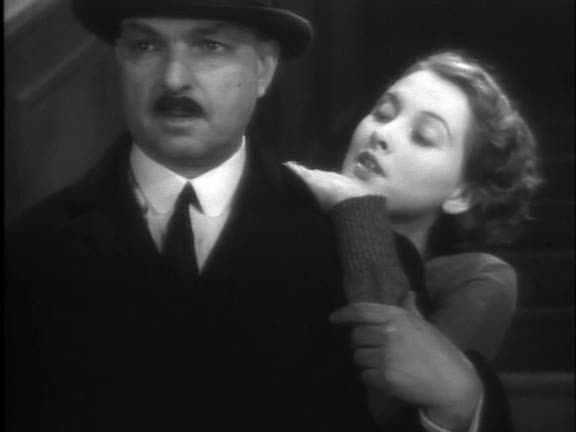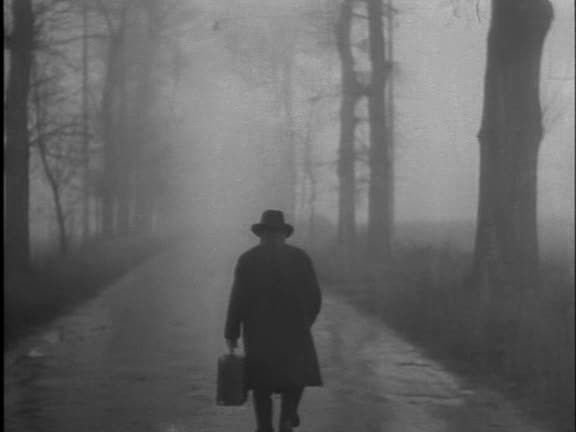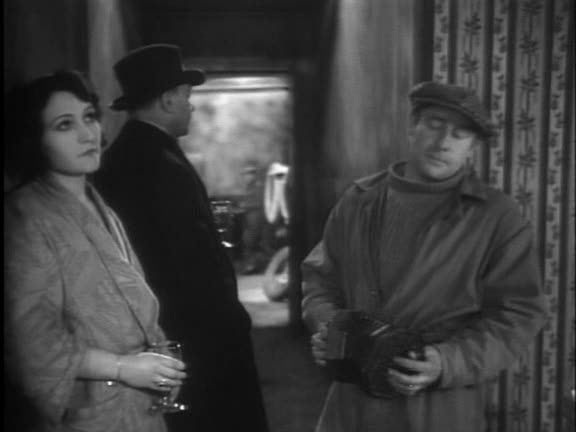
Jean Renoir's La nuit du carrefour is a rough, gritty film noir, set, as its title suggests, in a seeming perpetual night at a sleepy rural crossroads, a small settlement with just three houses and a gas station. This way station is always bathed in fog, isolated in the middle of the looming woods, where mysterious figures skulk through the dark on strange errands. A man shows up dead here, a jeweler, his body left in a stolen car in the garage of the Dutch immigrant Andersen (Georges Koudria), who insists that he's innocent. The French police suspect otherwise, but have nothing to prove it, and so they send the wily inspector Maigret (Renoir's brother Pierre) to investigate. Maigret is a great cinema detective in the traditional mold, clever and intelligent, able to piece together the facts from minimal evidence, observing every small detail and making deductions in the manner of Sherlock Holmes. In trying to make sense of this crime, he's confronted with no lack of suspects, but rather too many: Andersen's seductive sister Else (Winna Winifried), a true femme fatale; the gas station owner Oscar (Dignimont); Jojo (Michel Duran), the gas station attendant who flirts with Oscar's wife when no one (except the audience) is looking; the bourgeois Michonnet (Jean Gehret). All these people act suspiciously, creeping around, dropping knowing comments; they all seem to have some secret, to be willfully drawing suspicion to themselves, wandering through the foggy nights with guns, poisoning bottles of beer, smuggling contraband. Maigret seems to have stumbled into a confluence of odd events and shady characters.
Renoir builds this atmosphere brilliantly. His storytelling is extremely elliptical, marked by diversions that give the editing an abrupt, choppy rhythm (and it doesn't help that one reel of the film was lost outright, though such accidents seem appropriate for a film that already must have been especially loose and rough). When Andersen is first brought in for questioning, Renoir cuts away periodically to a curb-level shot of a local newsstand, capturing the passage of time through the transition from early edition to afternoon edition to evening edition to the evening paper getting swept away the next morning. Later, he frequently cuts away to some seemingly random event, some of the area's residents doing some inscrutable action, acting strangely. The night, and the fog hanging low over the tree-lined dirt roads, also serve as punctuation. At one point, in one of the most surreal interjections, Else is seen lying in her room, lazily smoking a cigarette, as a turtle crawls slowly along the bed next to her; it's baffling but evocative. The missing reel can only explain so much; at some point it becomes obvious that Renoir just doesn't seem especially concerned with narrative clarity. It's seldom clear who's shooting at whom until the obligatory parlor scene at the end, when the detective explains the film's events with such coherence and detail that one wonders how he managed to get all that out of this strange string of events.
That's part of the fun, of course, and Pierre Renoir plays the inspector with such charm and wit that his investigation, elliptical and aimless as it is, is seldom anything but entertaining to watch. Maigret always seems to have a little smirk on his lips, even when they're wrapped around a pipe. He's ahead of everyone else, and he knows it very well. Renoir lets the audience in on his deductions by drawing attention to the relevant objects at precisely the moment that Maigret notices them: a box of cigarettes that should be too expensive for its owner to afford regularly, a spare tire that doesn't match the truck that takes it. But the mystery isn't the point here. Instead, it's Renoir's power of observation that's being showcased. He's as interested in the details that reveal something about human behavior as the ones that reveal something about the mystery. This milieu is wonderfully detailed, with so much activity always going on in the fringes. It's rare that Renoir puts some action in the foreground and nothing else. The frame is always bustling, packed with nuances, like the way that, when Maigret calls the police station, the workers at the gas station go about their business all around him, while his boss at the station is surrounded by cleaning people going about their business behind him. Renoir's compositions are striking but somehow don't seem staged. There's messiness and imprecision in the way that he contrasts foreground and background, sometimes making the focus of the shot something other than what one would expect. When Maigret meets Else for the first time, the inspector and the Andersens are all in the blurry, out-of-focus background of the shot, while in the foreground, in crisp focus, a pile of furniture partially obscures the introduction. Renoir has this feel for making what might be considered "wrong" seem right: it feels real and unscripted, a casual introduction that will soon acquire a more pointed, artificial feel as Else begins her kittenish seduction of the inspector.


This is a film where setting and geography are very important. The crossroads, this small locale with a limited set of characters and places, is the site of most of the film's actions, and the denouement depends on the movement of characters between the area's three houses and the gas station. Earlier, the inspector's first visit to the Andersens' home is marked by his methodical examination of the drawing room, walking around the space as Else watches and describes some of the objects he sees; he stops by a music box, a record player, a box of cigarettes on the mantel, a tub of water in the next room. Renoir's camera motion and editing give the sequence the feel of an arc, tracing a curved line as the inspector circles the young woman, using the room and its objects to gauge her.
Else, of course, turns out to be crucial to the plot. She's a femme fatale in the classic sense, a treacherous woman with a dark past, and she's characterized as using sex to get her way. She tries it with the inspector, too, and nearly succeeds, and Renoir's presentation of her makes her so irresistible that it's not hard to see why: the light glistens off the buttons on her shirt, making her arms sparkle, and her bare leg, with a high stocking, is constantly creeping out into the open through the slit up the side of her dress. In the true noir tradition, she's the cause of all the problems for the men, trapping and corrupting men through her sexuality; the denouement is cleverly ambiguous, too, about whether she's really reformed in the end or not, as the inspector pushes her off in the right direction but not before her sly smile and instinctively sexy posture suggest that she's still got other ideas. It's typically sexist, to the extent that the femme fatale archetype is always about the dangerousness of female sexuality, but at the same time Else is such a compelling example of the form that she makes such concerns moot. Despite her few moments of weepy contrition, she enjoys being dangerous and destructive, and we enjoy watching her.
What's most refreshing about the film, though, is that Renoir approaches it all with such a wryly comic sensibility. Not that he doesn't take the mystery seriously, but that he's observing these noirish twists and turns with a slightly detached sense of irony. This comedic perspective is apparent in Maigret's slightly bumbling assistant Lucas (Georges Térof), who at one point has an entirely mimed and very funny interplay with Else when he believes that Andersen has poisoned a pot of tea; nothing is said, and the moment isn't emphasized, but is instead allowed to play out entirely in gestures in an offhand way. Later, a doctor (Max Dalban) shows up and keeps repeating the same laconic phrase ("Where is the patient?") over and over again to anyone who will listen, with the same drawling and intrinsically funny voice, and encounters only brush-offs and insults despite the fact that a man is badly wounded somewhere. Renoir also delights in the sarcastic, standoffish Jojo, who radiates thuggish charm and in free moments pinches the bottom of his boss' wife. These people may all turn out to be criminals and murderers of various stripes, but Renoir has some low-key affection for them too, mingled with satirical mockery. This film is smart, silly, funny, and exciting in roughly equal measures, using a mysterious murder and its aftermath as a way of closely examining this societal microcosm, pulling apart the seams to observe what's underneath.

2 comments:
So glad you're writing about this one. It's a key early Renoir that almost no one ever talks about. At least in the U.S.
This is indeed where film noir begins. And Renoir's mastery in this, and La Chienne testifies to just how complex and multi-facted his career was.
It's sadly overlooked and hard to see, David, very true. It's a brilliant film, and all the hallmarks of noir are already present here, which is pretty amazing to see. Even the femme fatale is one of the best of her kind.
Post a Comment